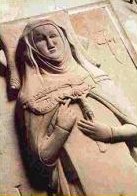Margareta Ebner
This article needs additional citations for verification. (September 2007) |
Blessed Margareta Ebner, O.P. | |
|---|---|
 Tomb of the Blessed Margareta in the Monastery Church of Maria Medingen | |
| Nun and Mystic | |
| Born | 1291 Donauwörth, Duchy of Swabia |
| Died | 20 June 1351 Mödingen, Prince-Bishopric of Augsburg |
| Venerated in | Roman Catholic Church (Dominican Order) |
| Beatified | 24 February 1979 by Pope John Paul II |
| Major shrine | Monastery of Maria Medingen |
| Feast | 20 June |
The Blessed Margareta Ebner, O.P., (1291 – 20 June 1351) was a German nun who is considered part of the tradition of German mysticism and a visionary. She seems to have been a niece of Christina Ebner, another Dominican nun and member of the group of mystics in the region at that time. She has been beatified by the Catholic Church.[1][2]
Life
Born in Donauwörth, Swabia, in 1291, Margareta was a member of the aristocratic Ebner family and she received a thorough education in her home. In about 1305, she entered the Monastery of Mary the Mother of Jesus Template:De icon of the Dominican Second Order nuns at Maria Medingen, near Dillingen.
From 1312 onward she was dangerously ill for three years. In her later Revelations she describes how she had "no control over herself", laughing or crying continuously for days at a time. This illness was the stimulus for her conversion to a deeper mystical life of devotion.[3] Subsequently, for a period of nearly seven years, she was mostly at the point of death. Even when she partially recovered, for the next thirteen years Margaret had to remain in bed for six months each year, and was subject to further bouts of illness for the rest of her life.[4] She could exercise her desire for penance and mortification only by abstinence from wine, fruit and bathing, which were considered some of the greatest pleasures of life in that era.
During this period of the Great Schism in the Catholic Church, when there were three different claimants to the papal throne, the nuns of the monastery were loyal adherents of the Pope in Rome. As a result, the community was forced to disperse during the military campaign of the Holy Roman Emperor Louis IV against papal forces. Margareta took refuge at her family home. Upon return, her nurse died, and Margaretha grieved inconsolably until the secular priest Henry of Nördlingen assumed her spiritual direction in 1332.

Eventually Master Henry had to flee Germany due to his personal allegiance to the Avignon Papacy. The correspondence that passed between them is the first collection of this kind in the German language. At his command, beginning during the Advent of 1344, she began to write with her own hand a full account of all her Revelations (Template:Lang-ger) and her conversation with the Infant Jesus, as well as all answers she had received from Him, even in her sleep. From the intimate nature of her interaction with the Divine Child, she has become a leading example of what is termed "mother-mysticism".[5] She wrote her visions in the Swabian dialect.
This journal is preserved in a manuscript of the year 1353 at Medingen. She also had extensive correspondence with the noted Dominican theologian and preacher, Friar Johannes Tauler. He was considered the leader of a lay spiritual movement known as the Friends of God. Through her connection with him, she has become identified as part of this movement. From her letters and diary we learn that she never abandoned her compassion for the Emperor Louis, whose soul she learned in a vision had been saved.
Ebner was beatified by Pope John Paul II on 24 February 1979.
Works
Margaret's experiences are mainly recorded in the "Revelations" (or "Offenbarungen"), which she composed in 1344–8 with the encouragement of her spiritual advisor and close friend Henry of Nördlingen, recounting the spiritual graces she received between 1312 and 1348. About seven manuscripts survive. There also remain fifty-six letters written by Henry of Nördlingen to Margaret (surviving in a single late manuscript), although only one of her letters to him survives.
References
- ^ Schwertner, Thomas M. (1913). . In Herbermann, Charles (ed.). Catholic Encyclopedia. New York: Robert Appleton Company.
- ^ Rabenstein, K. I. (2003). "Ebner, Margaretha, Bl.". New Catholic Encyclopedia. Gale. Retrieved 24 July 2013.
- ^ 2.7,as quoted in McGinn, Flowering, p309
- ^ McGinn, Flowering, p309.
- ^ Monastic Matrix "Margareta Ebhard"
Further reading
- The text of Margaret's "Offenbarung", as well as the surviving letters, are published in Philipp Strauch, Margaretha Ebner und Heinrich von Nördlingen: Ein Beitrag zur Geschichte der deutschen Mystik, (Freiburg/Tübingen: Mohr 1882)
- An English translation is in Leonard P Hindsley, Margaret Ebner: Major Works, (New York: Paulist Press, 1993)
- Bernard McGinn, The Flowering of Mysticism, (1998), pp308–314.
See also
![]() This article incorporates text from a publication now in the public domain: Herbermann, Charles, ed. (1913). Catholic Encyclopedia. New York: Robert Appleton Company.
This article incorporates text from a publication now in the public domain: Herbermann, Charles, ed. (1913). Catholic Encyclopedia. New York: Robert Appleton Company. {{cite encyclopedia}}: Missing or empty |title= (help)
- 1291 births
- 1351 deaths
- People from Donau-Ries
- German beatified people
- 14th-century venerated Christians
- German diarists
- Women of medieval Germany
- Rhineland mystics
- Christian mystics
- Members of Catholic religious orders and societies
- Dominican beatified people
- Dominican mystics
- Dominican nuns
- German Roman Catholic religious sisters and nuns
- Women diarists
- Beatifications by Pope John Paul II
